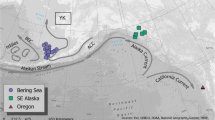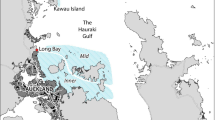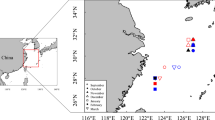Abstract
Statolith trace elemental concentrations can be used as natural tracers to better understand life history and stock structure of squid. A highly variable Humboldt squid population was targeted to determine if ontogenic patterns could be revealed and to compare variations among squid collected from three geographic areas. Statoliths from Humboldt squid collected off Westport, WA; Oceanside, CA; and the Galapagos Islands were sampled for ten trace elements using laser ablation inductively coupled plasma mass spectrometry. Similar patterns were found for some elements despite geographic collection site distances indicating a potential to explain ontogenic shifts experienced by this species. Other elements displayed high variation in spatial pattern, which suggests the potential to distinguish among the squid collected from the three geographic regions and better understand stock structure. Within the California and Washington squid, eight of the elements varied in relation to calcium across the statolith with only yttrium and zirconium remaining statistically invariant. In addition to these two elements, copper and zinc also did not vary significantly across the statoliths collected from Galapagos squid. All elements demonstrate potential to influence a multivariate elemental fingerprint, which may provide a useful measure of population discrimination needed for stock assessment.



Similar content being viewed by others
References
Arbuckle, N. S. M. & J. H. Wormuth, 2011. Statolith Extraction Method Improvements for Use in Microchemistry Studies with Laser Ablation Inductively Coupled Plasma Mass Spectrometry. MTS/IEEE Oceans, ‘11. Kona, Hawai’i, US.
Arkhipkin, A. I., 2005. Statoliths as ‘black boxes’ (life recorders) in squid. Marine and Freshwater Research 56: 573–583.
Arkhipkin, A. I., S. E. Campana, J. Fitzgerald & S. R. Thorrold, 2004. Spatial and temporal variation in elemental signatures of statoliths from the Patagonian longfin squid (Loligo gahi). Canadian Journal of Fisheries and Aquatic Sciences 61: 1212–1224.
Bettencourt, V. & A. Guerra, 2000. Growth increments and biomineralization process in cephalopod statoliths. Journal of Marine Biology and Ecology 248: 191–205.
Boyle, P. R. & S. Boletzky, 1996. Cephalopod populations: definition and dynamics. Philosophical Transactions of the Royal Society of London Series B 351: 985–1002.
Caddy, J. F. & P. G. Rodhouse, 1998. Cephalopod and groundfish landings: evidence for ecological change in global fisheries? Reviews in Fish Biology and Fisheries 8: 431–444.
Campana, S. E. & S. R. Thorrold, 2001. Otoliths, increments, and elements: keys to a comprehensive understanding of fish populations? Canadian Journal of Fisheries and Aquatic Sciences 58: 30–38.
Chan, L. H., D. Drummond, J. M. Edmund & B. Grant, 1977. On the barium data from the Atlantic GEOSECS expedition. Deep Sea Research 24: 613–649.
Clark, M. R., 1978. Cephalopod statolith: introduction to its form. Journal of the Marine Biological Association of the United Kingdom 58: 701–712.
Dawe, E. G., R. K. O’Dor, P. H. Odense & G. V. Hurley, 1985. Validation and application of an ageing technique for short-finned squid (Illex illecebrosus). Journal of Northwest Atlantic Fishery Science 6: 107–116.
Ehrhardt, N. M., 1991. Potential impact of a seasonal migratory jumbo squid (Dosidicus gigas) stock on a Gulf of California sardine (Sardinops sagax caerulea) population. Bulletin of Marine Science 49: 325–332.
FAO, 2008. The State of the World Fisheries and Aquaculture: 2008. Food and Agriculture Organization, Rome.
Gilly, W. F., U. Markaida, C. H. Baxter, B. A. Block, A. Boustany, L. Zeidberg, K. Reisenbichler, B. Robison, G. Bazzino & C. Salinas, 2006. Vertical and horizontal migrations by the jumbo squid Dosidicus gigas revealed by electronic tagging. Marine Ecology Progress Series 324: 1–17.
Jackson, G. D., 1994. Application and future potential of statolith increment analysis in squids and sepioids. Canadian Journal of Fisheries and Aquatic Sciences 51: 2612–2625.
Jochum, K. P., U. Weis, B. Stoll, D. Kuzmin, Q. Yang, I. Raczek, D. E. Jacob, A. Stracke, K. Birbaum, D. A. Frick, D. Gunther & J. Enzweiler, 2011. Determination of reference values for NIST SRM 610–617 glasses following ISO guidelines. Geostandards and Geoanalytical Research 35: 397–429.
Keyl, F., J. Arguelles, L. Mariategui, R. Tafur, M. Wolff & C. Yamashiro, 2008. A hypothesis on range expansion and spatio-temporal shifts in size-at-maturity of jumbo squid (Dosidicus gigas) in the Eastern Pacific Ocean. California Cooperative Oceanic Fisheries Investigations Reports 49: 119–128.
Kristensen, T. K., 1980. Periodical growth rings in cephalopod statoliths. Dana 1: 39–51.
Lipinski, M. R., 1980. Statoliths as a possible tool for squid age determination. NAFOSCR Document 80/11/22, Revised, Ser. No. N054: 12.
Lipinski, M. R., 1986. Methods for the validation of squid age from statoliths. Journal of the Marine Biological Association of the United Kingdom 66: 505–526.
Lipinski, M. R., M. D. Durholtz & G. Underhill, 1998. Field validation of age readings from the statoliths of chokka squid (Loligo vulgaris reynaudii D’Orbigny, 1845) and an assessment of associated errors. ICES Journal of Marine Science 55: 240–257.
Liu, B., X. Chen, Y. Chen, H. Lu & W. Qian, 2011. Trace elements in the statoliths of jumbo flying squid off the exclusive economic zones of Chile and Peru. Marine Ecology Progress Series 429: 93–101.
Markaida, U., 2006. Food and feeding of jumbo squid Dosidicus gigas in the Gulf of California and adjacent waters after the 1997–98 El Niño event. Fisheries Research 79: 16–27.
Markaida, U., J. J. C. Rosenthal & W. F. Gilly, 2005. Tagging studies on the jumbo squid (Dosidicus gigas) in the Gulf of California, Mexico. Fishery Bulletin 103: 219–226.
Mejia-Rebollo, A., C. Quinonez-Velazquez, C. Salinas-Zavala & U. Markaida, 2008. Age, growth, and maturity of jumbo squid (Dosidicus gigas D’Orbigny, 1835) off the western coast of the Baja California peninsula. CalCOFI Reports 49: 256–262.
Morris, C. C., 1991. Statocyst fluid composition and its effects on calcium carbonate precipitation in the squid Alloteuthis subulata (Lamarck, 1798): towards a model for biomineralization. Bulletin of Marine Science 49: 379–388.
Nakamura, Y. & Y. Sakurai, 1991. Validation of daily growth increments in statoliths of Japanese common squid Todarodes pacificus. Nippon Suisan Gakkaishi 57: 2007–2011.
Rodhouse, P. G., K. Robinson, S. B. Gajdatsy, H. I. Daly & M. J. S. Ashmore, 1994. Growth, age structure and environmental history in the cephalopod Martialia hyadesi (Teuthoidea, Ommastrephidae) at the Antarctic polar frontal zone and on the Patagonian shelf edge. Antarctic Science 6: 259–267.
Rooker, J. R., D. H. Secor, V. S. Zdanowicz, G. de Metrio & L. O. Relini, 2003. Identification of Atlantic bluefin tuna (Thunnus thynnus) stocks from putative nurseries using otolith chemistry. Fisheries Oceanography 12: 75–84.
Ruttenberg, B. I., S. L. Hamilton, M. J. H. Hickford, G. L. Paradis, M. S. Sheehy, J. D. Standish, O. Ben-Tzvi & R. R. Warner, 2005. Elevated levels of trace elements in cores of otoliths and their potential for use as natural tags. Marine Ecology Progress Series 297: 273–281.
Warner, R. R., S. L. Hamilton, M. S. Sheehy, L. D. Zeidberg, B. C. Brady & J. E. Caselle, 2009. Geographic variation in natal and early larval trace-elemental signatures in the statoliths of the market squid Doryteuthis (formerly Loligo) opalescens. Marine Ecology Progress Series 379: 109–121.
Watanabe, K., Y. Sakurai, S. Segawa & T. Okutani, 1996. Development of the ommastrephid squid Todarodes pacificus, from fertilized egg through to rhynchoteuthion paralarva. American Malacological Bulletin 13: 73–88.
Wormuth, J. H., 1976. The biogeography and numerical taxonomy of the oegopsid squid family Ommastrephidae in the Pacific Ocean. Bulletin of Scripps Institute of Oceanography 23: 1–90.
Zacherl, D. C., G. Paradis & D. W. Lea, 2003. Barium and strontium uptake into larval protoconchs and statoliths of the marine neogastropod Kelletia kelledi. Geochimica Et Cosmochimica Acta 67: 4091–4099.
Zeidberg, L. D. & B. H. Robison, 2007. Invasive range expansion by the Humboldt squid, Dosidicus gigas, in the eastern North Pacific. Proceedings of the National Academy of Sciences of the United States of America 104: 12946–12948.
Zumholz, K., T. H. Hansteen, A. Klugel & U. Piatkowski, 2006. Food effects on statolith composition of the common cuttlefish (Sepia officinalis). Marine Biology 150: 237–244.
Zumholz, K., A. Klugel, T. Hansteen & U. Piatkowski, 2007. Statolith microchemistry traces the environmental history of the boreoatlantic armhook squid Gonatus fabricii. Marine Ecology Progress Series 333: 195–204.
Acknowledgments
The authors acknowledge Texas A&M University Oceanography Department; Instituto Oceanografico de la Armada (INOCAR); William Radiogenic Isotope Geosciences Lab personnel; Dr. Cin-Ty Lee, Rice University; Coroloma Sport Fishing, Oceanside, California; Dr. Kirt Onthank, Washington State University.
Author information
Authors and Affiliations
Corresponding author
Additional information
Guest editors: Erica A. G. Vidal, Mike Vecchione & Sigurd von Boletzky / Cephalopod Life History, Ecology and Evolution
Rights and permissions
About this article
Cite this article
Arbuckle, N.S.M., Wormuth, J.H. Trace elemental patterns in Humboldt squid statoliths from three geographic regions. Hydrobiologia 725, 115–123 (2014). https://doi.org/10.1007/s10750-013-1608-4
Received:
Accepted:
Published:
Issue Date:
DOI: https://doi.org/10.1007/s10750-013-1608-4




